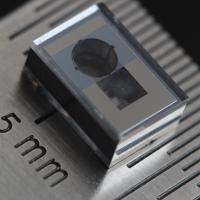Cavity-stabilized lasers and Microwave Photonics
Ultra stable Lasers (contact: Yann Kersalé)

The aim of this project is to build ultra stable lasers for metrological and space applications. The lasers are stabilized to ultra stable F
A continuous-wave (CW) laser is locked to an ultra high finesse Fabry-Perot cavity using the Pound-Drever-Hall (PDH) technique. In that case the laser relative frequency fluctuations will be equal to the cavity relative length fluctuations.abry-Perot cavities. Four lasers are under construction. 2 at room temperature (spherical cavity and the ultra-compact cavity) and 1 at cryogenic temperature (silicon cavity at 17 K)
Room temperature ultra stable cavities:
- Spherical cavity

The cavity is a 5 cm long commercial spherical cavity based on a design by NIST. The spherical spacer, in ULE, is held at an optimized angle for minimizing vibration sensitivity. Fused-Silica mirror substrates are optically contacted to a spherical ULE spacer; ULE rings are placed on the SiO2 substrates to adjust the cavity inversion temperature at 10,5°C.
We have obtained a residual SSB phase noise of L(f) = -104 dBc/Hz at 1 Hz offset frequency for a 10 GHz carrier. The obtained relative frequency stability is 1.9x10-15 at 1 s. Our goal is to reach the thermal noise floor of the cavity at 8.10-16 at short integration times.
See also: Ultra-low phase noise all-optical microwave generation setup based on commercial devices, A. Didier et al., Applied Optics 54, pp. 3682-3686, 2015.
- Ultra-compact cavity
 The objective here is the realization of an Ultra compact (40 liters) laser stabilized on a small Fabry Perot cavity with frequency instability lower than 10-14 at short term in order to propose a new alternative for compact ultra stable oscillators (like quartz for example). The ULE cavity is 2.5 cm long with crystalline coatings on fused silicate mirror. The calculated sensitivity to vibration is lower than 10-12 m/s-2 in each directions. The thermal noise floor was calculated to be 1.2x10-15.
The objective here is the realization of an Ultra compact (40 liters) laser stabilized on a small Fabry Perot cavity with frequency instability lower than 10-14 at short term in order to propose a new alternative for compact ultra stable oscillators (like quartz for example). The ULE cavity is 2.5 cm long with crystalline coatings on fused silicate mirror. The calculated sensitivity to vibration is lower than 10-12 m/s-2 in each directions. The thermal noise floor was calculated to be 1.2x10-15.
Cryogenic ultra stable cavity
 The objective here is the realization of a laser with frequency instability lower than 10-16 at short term for metrological applications and in particular for the neutral optical clocks local oscillator.
The objective here is the realization of a laser with frequency instability lower than 10-16 at short term for metrological applications and in particular for the neutral optical clocks local oscillator.
The cavity is in silicon which has two temperatures (124 K and 17 K) where its linear expansion coefficient is equal to zero. The calculated sensitivity to vibrations is less than 5x10-12 m/s-2 in each directions.
In order to reach the cavity thermal noise floor (4x10-17) we have developed a very low vibration cryocooler in collaboration with the french company Mycryofirm.

